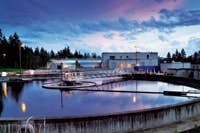The staff at the Rock Creek Advanced Wastewater Treatment Facility seem well aware that innovation is the key to success, and they do not have plans to slow down anytime soon.
The facility, one of four treatment plants run by Clean Water Services (CWS) of Hillsboro, Ore., began service in 1977. CWS formed in 1970 as a result of a 1969 Washington County building moratorium, according to Nathan Cullen, engineering division manager for CWS. The biggest bond issue in Oregon history provided the initial funds to create CWS. The organization went after $35 million in voter-approved general obligation bonds in 1970 to fund the new regional wastewater authority.
CWS was able to tap into Clean Water Act grants for the initial construction of its first plants: Rock Creek and Durham. “We were 75% to 80% federally funded through grants initially. But all subsequent expansions have been self-funded through rates and system development charges,” Cullen said.
Rock Creek is a tertiary treatment plant that degrits primary sludge without grit basins. “And then we have two parallel treatment trains, the east side and west side of the facility, each of which go all the way to disinfection,” said Peter Schauer, process engineer for CWS. “They’re conventional activated sludge three-stage processes. The west side is a conventional activated sludge process followed by flocculation and tertiary clarifiers. But the east side has the Claricones for tertiary treatment, which treat about a third of the plant flow, and [another] third of the plant flow also on the east side is treated by direct filtration.”
Changes & Upgrades
Several projects are in the works at Rock Creek, with plans for even more to come. On May 1, the facility started converting to biological phosphorous removal, which Cullen said is proving to be a large undertaking.
According to Schauer, the upgrade will pay off—not only with the reduction in chemicals, but by switching to biological phosphorous removal. He said the plant now is able to create a centrate stream containing a higher amount of soluble phosphorous, so it can recover it in the struvite facility, providing an additional revenue stream. Rock Creek’s maintenance and operations building is getting a boost as well with the installation of a solar panel facility that will use solar photovoltaic cells.
Rock Creek also is in the process of constructing a ballasted flocculation and sedimentation system on the west side of the facility to replace its flocculation and sedimentation basins and tertiary clarifiers, Schauer said.
Work also is being done on some pilot projects for onsite fermentation using waste sugar products. Rock Creek is looking into a permanent fermentation system in the future.
The plant’s staff is currently designing a future gravity fermenter that will be part of the main solids handling process, and they are also in preliminary design for heat treat systems to condition the sludge before it goes into the anaerobic digesters, Cullen said. In addition, Rock Creek is expanding its headworks capacity and adding another bar screen at the headworks that will take the capacity from 160 to 200 million gal per day.
Challenges
According to Cullen, the continuous upgrades are a big help when dealing with the area’s strict nutrient limits, including some of the most stringent phosphorous limits in the country. “Our receiving stream, the Tualatin River, is prone to algae blooms if we don’t control the phosphorous,” he said.
Rock Creek has a median total phosphorous limit of 0.1 mg/L. Its summertime nutrient removal also includes ammonia.
During Oregon’s rainy, wet winters, the focus switches to managing the correspondingly high peak flows. At Rock Creek, it is a 6-to-1 peaking factor—peak hour to annual average flow.
Until now, the plant has managed the stringent phosphorous limits through chemical treatment, so the biological removal is a big transition.
Schauer said it has been going well so far; the plant has been able to biologically remove the majority of the soluble ortho-phosphorous that is in the secondary system this year.
On the Horizon
According to Cullen, there is much more still to come. “One of the big projects is to expand our cogeneration facility,” he said. The facility currently has 1 MW of cogeneration capacity. In the future, Cullen said CWS would likely upgrade and expand that facility to generate more power.
“There’s a lot going on,” he said. “We’re pretty much in a continual expansion at our facilities.”
Rock Creek’s innovative ways are nothing new. “There’s a long history of innovation at the district,” Cullen said.
It must be something in the water.
Download: Here


